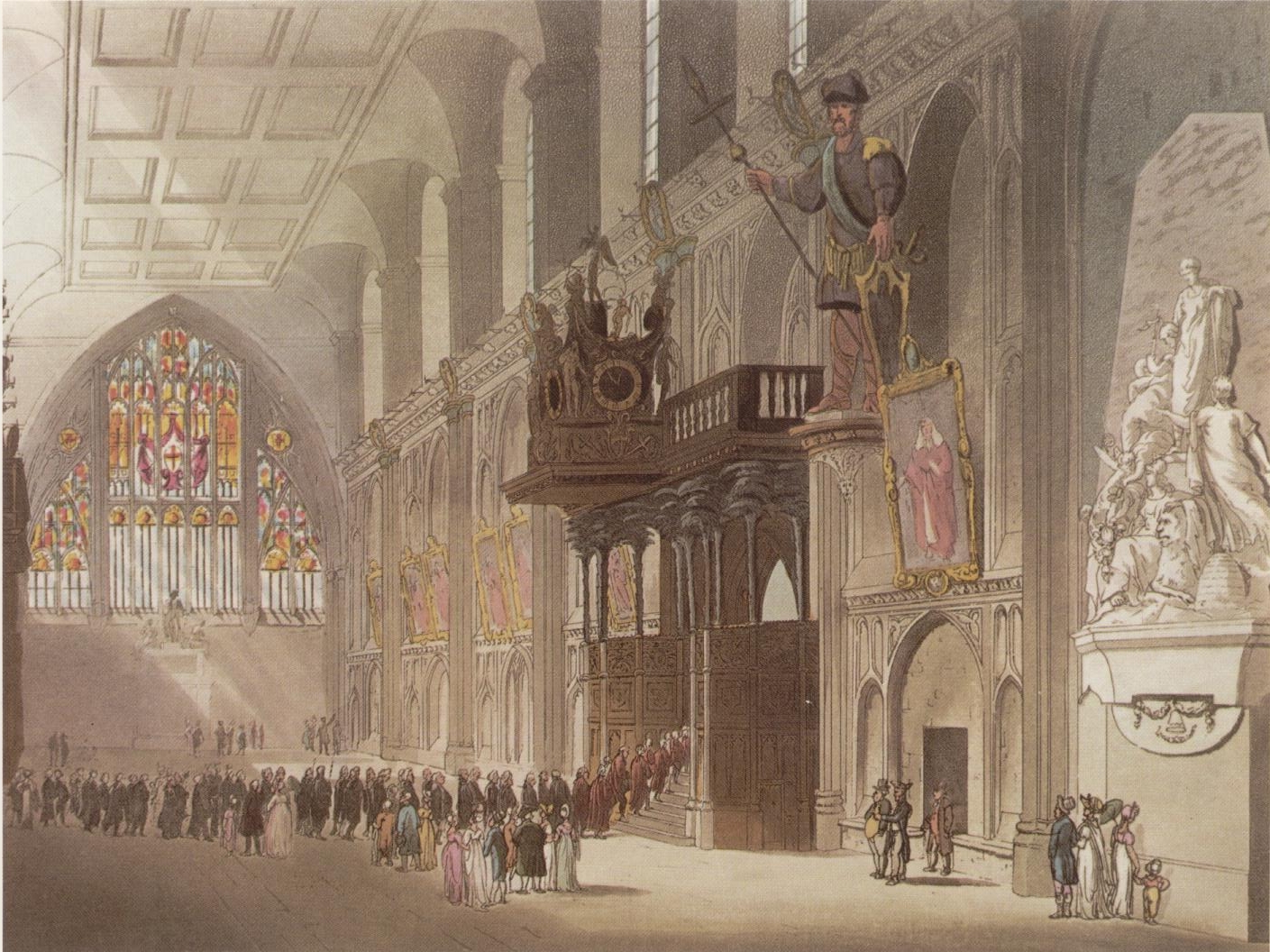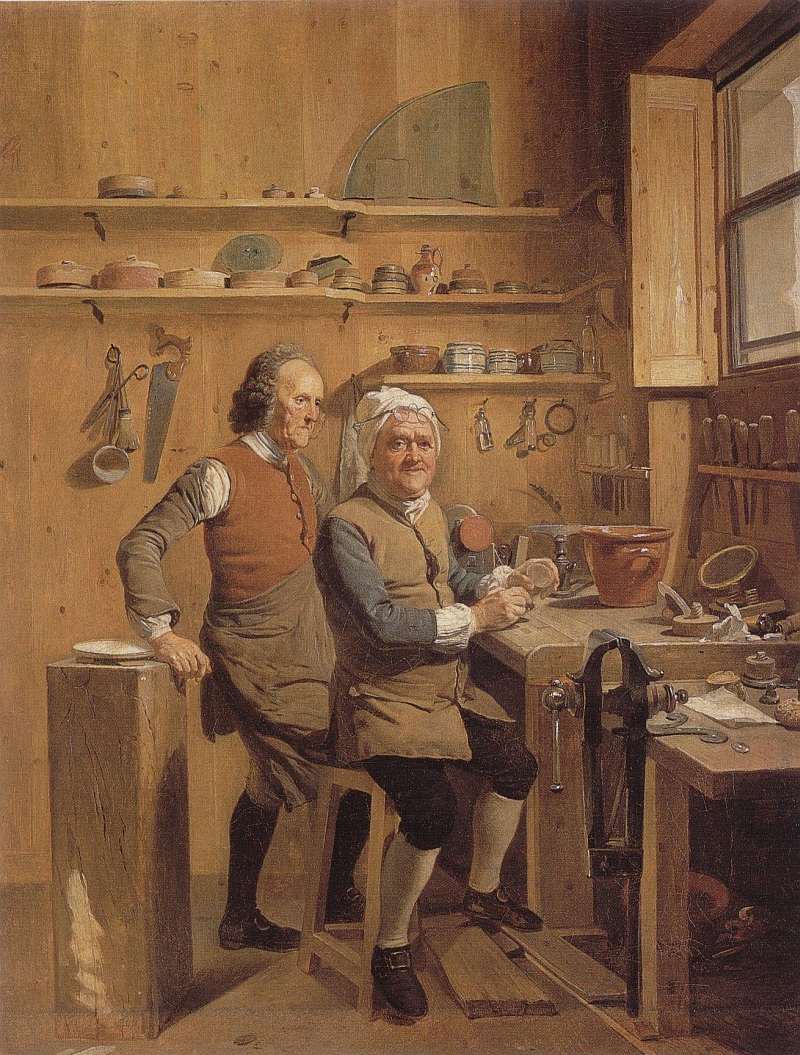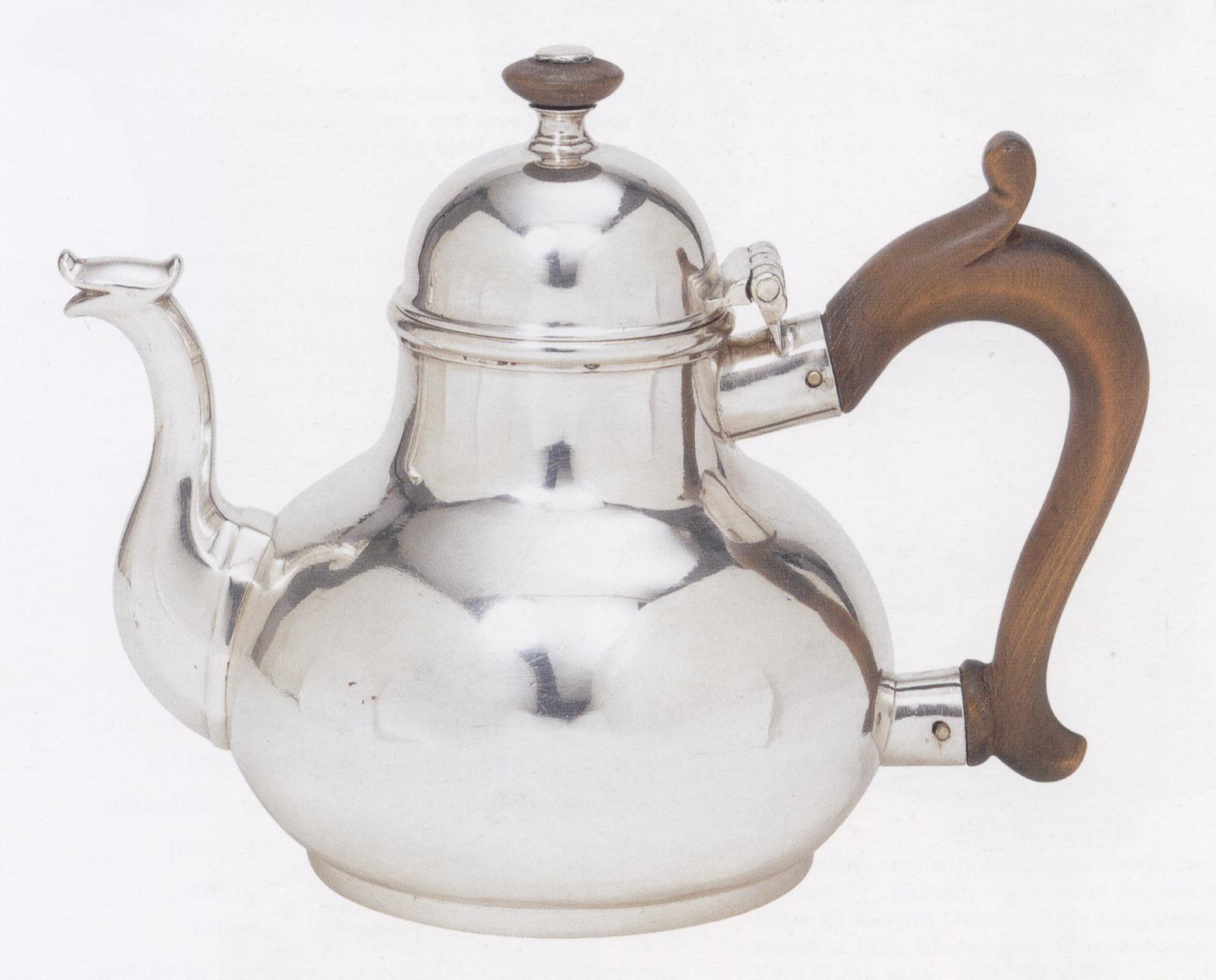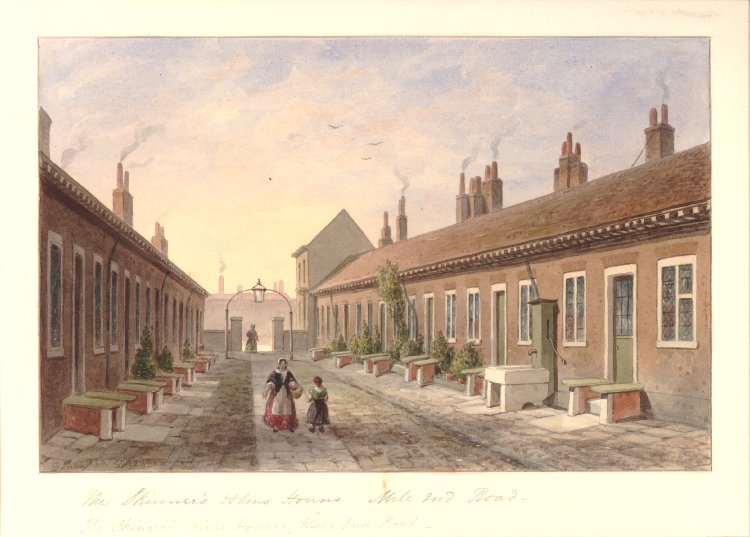Guilds
 Thomas Rowlandson, The Guildhall, from The Microcosm of London, 1808.
Thomas Rowlandson, The Guildhall, from The Microcosm of London, 1808.
Introduction
Guilds composed of workmen from specific trades and crafts were established in the middle ages. Their purpose was to defend the interests of the trade, regulate the quality of workmanship and the training of new members, and provide support and welfare for their members. Established by charter and regulated by the City of London, London's guilds also provided a political voice to their members, who as freemen of the City had the right to elect members of the Court of Aldermen and Common Council. London had eighty-nine guilds in the eighteenth century, ranked according to a hierarchy of precedence with the twelve Great Companies at the top. The powers of the guilds to regulate economic activity declined substantially in the eighteenth century, and their primary functions were increasingly confined to providing social prestige, business contacts and a political voice to their members. They also provided substantial charity to their members, partly funded by large charitable bequests which they administered.
This website includes the records of one guild, the Carpenters' Company.
Membership
Membership in a guild could be taken up in one of three ways: by completing a seven year apprenticeship, by patrimony (if one's father was a member of the company), or by redemption (payment of a fee). None of these routes of entry ensured that the member would actually practice the company's trade. Owing to the Custom of London, members of London guilds could practise any trade in the City. Consequently, even though a completed apprenticeship remained the most common route to membership, guilds often included numerous members who did not actually practice the relevant trade. The ratio of members practising the craft to others varied from guild to guild, with the less prestigious guilds such as the Carpenters' Company having a larger number of practicing craft members. Other companies, such as the Grocers', Fishmongers', and Goldsmiths', had many fewer practising members, and, owing to the high cost of admission, became "little more than gentleman's clubs".1
 John Cuff, Master of the Worshipful Company of Spectacle Makers. By Johann Zoffany, 1772. © The Royal Collection.
John Cuff, Master of the Worshipful Company of Spectacle Makers. By Johann Zoffany, 1772. © The Royal Collection.
Most guilds were composed of men from a mixture of social backgrounds. Apprentices were almost invariably young and came from both relatively poor and wealthy homes. Journeymen, craftsmen who had finished their apprenticeship but had not set up an independent business, were relatively poorly paid. Master craftsmen ran anything from a small one-man workshop to a thriving business with several apprentices, journeymen, and partners in other trades. By the eighteenth century most guilds did not include women, though sometimes widows who took over their husbands' businesses became members by default, and took over the training of their husbands'apprentices. Even in this instance, women were excluded from participation in company business.
Guilds were normally governed by a master, two wardens, and a Court of Assistants, which set policies, oversaw the administration of company properties, and governed the distribution of charitable funds.
Apprenticeship
As is evident from the experience of the Carpenters' Company, the traditional seven year apprenticeship, in which a teenage boy (or more rarely, girl) was indentured to a master in order to learn a trade, continued to be important in the eighteenth century. Not only did apprenticeship provide an attractive means of delivering vocational training and securing a child's future, but it remained an important facet of the process of leaving home and becoming socialised into adulthood.
Nonetheless, the number of guild apprentices stagnated in London and the social background of apprentices narrowed. Since guilds gradually lost control over entry into their craft, work was increasingly available to those who had not served an apprenticeship. Many families chose not to pay the expensive premiums; between 1715 and 1718, the average premium demanded in London was £28. Consequently, apprenticeship was increasingly restricted to boys from prosperous backgrounds, who were indentured to the more prestigious companies and professions (architects, attorneys, surgeons).2
At the other extreme, apprenticeship continued to be used by parishes as a means of training pauper children. Children from respectable households might also be bound as Bridewell apprentices; but boys from lower-class backgrounds who were not paupers were increasingly unlikely to become apprentices. Girls did not enter Bridewell apprenticeships, and were very rarely guild apprentices, but they did serve as parish apprentices, almost exclusively to the trade of housewifery.
 An English pear-shaped teapot with London hallmarks for 1713-14, and a maker's mark for Thomas Folkingham. © Victoria and Albert Museum.
An English pear-shaped teapot with London hallmarks for 1713-14, and a maker's mark for Thomas Folkingham. © Victoria and Albert Museum.
Apprenticeships registered with the guilds were regulated by them. Guilds enrolled the indentures, mediated complaints, and registered those who completed their apprenticeships as freemen. Due to their declining powers, however, guilds lost the ability to regulate the number of apprentices a master could supervise, fundamentally undermining their ability to police the behaviour of masters. Apprentices who claimed they were mistreated or abandoned by their masters, as well as masters who complained that their apprentices misbehaved, could also take their complaints to a Justices of the Peace as an alternative to the guild. The Justice might mediate the dispute informally, bind one of the parties over to appear at the sessions of the peace, or commit the apprentice to a house of correction.
The London Lives website does not include any guild apprentice registers. However, apprentices bound to the Carpenters' Company are recorded in their Court of Assistants Minute Books (MC) and, as explained in the Research Guide, apprentices appear in several other types of non-guild records.
Decline
From the late seventeenth century, the powers of the London guilds to regulate entry into their trades and enforce standards of workmanship declined. For some trades, including the Carpenters' Company, this decline was precipitated by the Great Fire of 1666, when, to facilitate rapid rebuilding, guild powers were relaxed for a period of seven years, allowing non-members who had served apprenticeships elsewhere in the country to work in London. Following the expiration of this period it proved difficult for many guilds to re-acquire the powers they had lost. Longer-term trends also undermined their position. These included the growth of the metropolis outside the boundaries of the City of London (where guild powers were more difficult to enforce), the migration of some trades to other parts of the country, and the development of new trades in London which were unregulated by guilds. The contemporary development of ideas about free trade and legal challenges to guild authority also contributed to this decline.
Although the guilds still had an important role to play in City politics and the administration of their charities, their economic function largely disappeared. Symptomatic of this decline is the fact that industrial disputes in the eighteenth century took place with little reference to the guilds. Disputes between masters and their wage-earning journeymen and labourers pitted members of a trade one against the other, and the guilds found no role in these disputes. Instead, perhaps building on bonds formed within their guilds, groups of workers in several trades, including the Carpenters, formed clubs and societies to push for better wages and working conditions. While workers used strikes and demonstrations to advance their cause, masters fought back using the police and the criminal and civil courts.
Charity
 Thomas Hosmer Shepherd. The Skinners' Almshouses. 1854. © Trustess of the British Museum.
Thomas Hosmer Shepherd. The Skinners' Almshouses. 1854. © Trustess of the British Museum.
Guilds played a major role in the provision of charity, though primarily only to their own members. Indeed, a major reason for the continuing popularity of membership in the eighteenth century must have been the knowledge that the company would provide support for members and their widows in old age, and when they fell on hard times.
Guild charity took two forms: the administration of legacies left by former members, and the distribution of the company's own funds. Throughout the early modern period wealthy members occasionally bequeathed property or funds for specific purposes such as annual payments to a certain number of poor widows or freemen of the company. (For examples, see the bequests to the Carpenters' Company). These pensions were also frequently supplemented by the provision of sheltered accommodation in almshouses. Owing in part to concerns about the management of such funds, however, the practice of leaving money in bequests for these purposes declined in the late seventeenth century, and it became more fashionable to donate money during one's lifetime to associational charities.
Guilds also made regular payments to the poor from their own funds, generated by fees and dues paid by their members and income from their properties. These payments took various forms, including cash pensions, one-off casual payments, grants of fuel and clothing, and residence in almshouses. Guilds were particularly concerned to support high status members who had fallen on hard times.
Although the amount of money guilds spent on charity declined in the eighteenth century, it was still a significant source of support for poor members.3 Requests for assistance, often drafted by scriveners and possibly also by parish officers, formed a significant portion of the business conducted by guild officers.4.
Introductory Reading
- Archer, Ian. The Livery Companies and Charity in the Sixteenth and Seventeenth Centuries. In Gadd, Ian Anders and Wallis, Patrick, eds, Guilds, Society & Economy in London 1450-1800. Centre for Metropolitan History, Institute of Historical Research in association with the Guildhall Library, 2002, pp. 15-28.
- Brooks, C. W. Apprenticeship, Social Mobility and the Middling Sort. In Barry, J. and Brooks, C. W., eds, The Middling Sort of People. Basingstoke, 1994, pp. 52-83.
- Kellet, J.R. The Breakdown of Gild and Corporation Control over the Handicraft and Retail Trades in London. Economic History Review, 2nd series, 10 (1957-58), pp. 381-94
For further reading on this subject see the London Lives Bibliography.
Footnotes
1 C. W. Brooks, Apprenticeship, Social Mobility and the Middling Sort, in J. Barry and C. W. Brooks, eds, The Middling Sort of People (Basingstoke, 1994), p. 81. ⇑
2 Brooks, Apprenticeship, Social Mobility and the Middling Sort, pp. 67-68. ⇑
3 Ian Archer, The Livery Companies and Charity in the Sixteenth and Seventeenth Centuries, in Ian Gadd and Patrick Wallis, eds, Guilds, Society & Economy in London 1450-1800 (Centre for Metropolitan History, Institute of Historical Research in association with the Guildhall Library, 2002), pp. 17-25. ⇑
4 Joseph P. Ward, Metropolitan Communities: Trade Guilds, Identity, and Change in Early Modern London (Stanford, California, 1997), pp. 80-81 ⇑